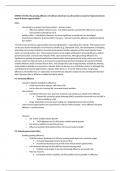HFDYAT 1941-80, the growing affluence of ordinary Americans was the primary reason for improvements in
travel & leisure opportunities?
Intro:
- Convincing to an extent, but federal action = primary reason
o Affluence explains initial increase – but federal policies sustained the affluence & ensured
more people could take part in it
- Industry shifts = contributory (however, not most significant as would not have developed
travel/leisure industries if demand didn’t increase – demand caused by affluence enabled by federal
gov. action)
1941-80, travel and leisure opportunities improved significantly – especially in the suburbs. This improvement
can be seen by the introduction of new leisure activities (e.g. Disneyland 1955), the development of shopping
and eating out as leisure activities, increased consumerism and the expansion of the travel industry (more
roads, car-owning culture, etc.). These improvements can be largely attributed to: growing affluence, federal
government action, and economic/industry shifts. Upon assessment, although growing affluence was
significant in sparking increased travel/leisure opportunities, federal government action can be seen as the
primary reason for improvements as it ensured a sustained improvement throughout the period (1941-80),
enabled affluence itself, increased leisure time, and enlarged the scale of opportunities available by allowing
more people to partake in consumerism. Industry shifts can be seen as a contributory factor as although they
contributed to increased opportunities, industry shifts alone (i.e. if not for federal action and growing
affluence) are insufficient as an explanation as travel/leisure industries would not have developed if demand
didn’t increase (due to affluence enabled by federal action).
P1: Increased affluence
- Growth of suburbs (enabled by affluence)
o 19mil more lived in suburbs 1960 than 1950
o Led to: drive-ins, leisurely life, increased leisure activities
- Consumerism
o Considered ‘American way’ post-war (scrimp & save during war, people more affluent)
Demand for consumer goods following WW2: production increased from $213bil in
1945 to $284bil in 1950
o Larger proportion of income spent eating out, shopping became leisure activity
- Leisure/travel opportunities most prominent in suburbs (where people = more affluent) therefore
affluence = primary reason
- However…
o fed. Action enabled suburb growth
1956 Highways Act (41,000 miles) enabled suburb growth
o Fed action enabled increased leisure time
o Affluence sparked initial opportunities, fed ensured scale & length
P2: Federal government action
- Enabled growing affluence
o 1938 Fair Labour Standards Act (40-hour working week legal max, minimum wage)
Increased disposable income & leisure time
Incentivised businesses to provide more leisure/travel opportunities
o 1949 National Housing Act (810,000 low-income housing units)
Enabled more people to be part of growing affluence, Increased scale
o Post-war recovery
Continued wartime subsidies, GI bill (enabled more to partake in affluence)




